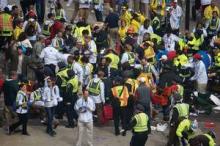If there’s one piece of advice that Boston emergency physicians have for their peers following the Boston Marathon bombings, it’s this: drill, drill, drill.
"No matter how much drilling you do, you will never really prepare yourself for what this is like," said Dr. Ron M. Walls, chairman of the department of emergency medicine at Brigham and Women’s Hospital.
"But I would encourage everyone to plan those drills, take them seriously, do them well, and do them often. There’s no question that the expertise of emergency physicians and surgeons and nurses is crucial at the time of response, but being part of the systematic response and knowing that you’re part of systematic response is also very important."
On Monday afternoon, April 15, before the two improvised explosive devices detonated near the finish line of the Boston Marathon, killing three and injuring more than 170 people, Dr. Walls was in his office with his department administrator going over the budget. Suddenly, an alert went through the phone system. A news banner popped up on his phone.
"And then I heard an absolute cacophony of sirens, more than I had ever heard anywhere," he said in an interview.
Boston is unique when it comes to emergency and trauma care. It has five level 1 trauma centers. And Massachusetts was one of the first states to ban ambulance diversions in 2009. As a result, hospitals have created protocols to move patients quickly and make room in the ED.
"EMS [emergency medical services] did a beautiful job of distributing the patients at Beth Israel Deaconess Medical Center. There wasn’t any point where we felt truly overwhelmed," said Dr. Richard E. Wolfe, chief of emergency medicine at the medical center.
And the drills and preparations helped. While mass casualty drills have been a part of hospital operations for years, the 9/11 terrorist attacks brought the importance of preparation to the forefront.
"We’ve had a big shift in education," said Col. John McManus, MC, USA (ret.), an emergency physician who was among the last to leave Iraq in 2011. "Even though we learned a lot of these lessons from World War II and Vietnam, we kind of forgot about some of it. They were published, but we didn’t keep them in the cutting edge of medicine. We felt like it was never going to happen here, and that the military had to deal with it. After 9/11, unfortunately, we realized that we were underprepared and undertrained to treat these kinds of casualties."
Brigham and Women’s Hospital has held 73 disaster preparation drills since 2006, including citywide drills with Boston EMS, Dr. Walls said.
Now, the many hospitals have physicians, nurses, and other personnel on staff who have served in combat situations. Federal agencies, medical societies, and private entities are collaborating to update training and medical information. "The majority of scientific meetings include military and blast education," Dr. McManus, vice president of medical affairs at Masimo Corporation, said in an interview.
"What’s happened since Sept. 11 is that people are much more focused on disaster management and mass casualty events," Dr. Wolfe said in an interview. At Beth Israel Deaconess Medical Center, "we’ve had speakers from Israel doing visiting fellowships with us. We had Dr. Chris Caldwell, who helped coordinate the Aurora and Columbine disaster responses, as a visiting professor with us, walking us through the lessons learned in Columbine.
"It’s become part of residency training and didactic programs, and has really developed a culture of knowledge in terms of mass casualty events, in a way that we didn’t have in the 80s and 90s," Dr. Wolfe said.
And after each disaster, be it Hurricane Katrina or the Boston Marathon, hospitals improve their protocols and share what they’ve learned. Both Dr. Walls and Dr. Wolfe said they wanted to improve communication, whether it’s within the hospital and between the departments, or whether it’s with outside staff who may feel left out of the loop.
On Monday afternoon, Dr. Wolfe had just gotten home when he saw television reports of the bombing. He called his ED and headed back to work. Within minutes, ED personnel levels increased fivefold as patients began to arrive.
He quickly established crowd control in the ED, and put some of the volunteers on the reserve and on the sidelines. He also created zones, where people worked in small pockets. There was a disaster coordinator on the scene "so we had all the right people," Dr. Wolfe said.


